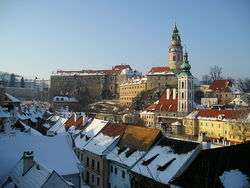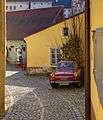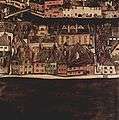Český Krumlov
| Český Krumlov | |||
| Crumlaw | |||
| Town | |||
 | |||
|
|||
| Country | Czech Republic | ||
|---|---|---|---|
| Region | South Bohemian | ||
| District | Český Krumlov | ||
| Commune | Český Krumlov | ||
| River | Vltava | ||
| Elevation | 492 m (1,614 ft) | ||
| Coordinates | CZ 48°49′N 14°19′E / 48.817°N 14.317°ECoordinates: CZ 48°49′N 14°19′E / 48.817°N 14.317°E | ||
| Area | 22.16 km2 (8.56 sq mi) | ||
| Population | 14,056 (2007-09-24) | ||
| Density | 634/km2 (1,642/sq mi) | ||
| First mentioned | 1253 | ||
| Mayor | Dalibor Carda | ||
| Timezone | CET (UTC+1) | ||
| - summer (DST) | CEST (UTC+2) | ||
| Postal code | 381 01 | ||
| UNESCO World Heritage Site | |||
| Name | Historic Centre of Český Krumlov | ||
| Year | 1992 (#16) | ||
| Number | 617 | ||
| Region | Europe and North America | ||
| Criteria | iv | ||
  Location in the Czech Republic | |||
| Wikimedia Commons: Český Krumlov | |||
| Statistics: statnisprava.cz | |||
| Website: www.ckrumlov.info | |||
Český Krumlov (Czech pronunciation: [ˈtʃɛskiː ˈkrumlof]; German: Krummau an der Moldau or Böhmisch Krummau; Krumau; English: Crumlaw,[1][2]), sometimes translated as Czech Crumlaw, is a small city in the South Bohemian Region of the Czech Republic where Český Krumlov Castle is located. Old Český Krumlov is a UNESCO World Heritage Site[3] and was given this status along with the historic Prague castle district.
The city is named Český Krumlov ("Bohemian Crumlaw") to differentiate it from Moravský Krumlov in South Moravia.
History
Construction of the town and castle began around 1240 by the Vítkovci at a ford in the Vltava River, at an important trade route in Bohemia. It was first mentioned in 1253 as Chrumbenowe. A legend says that the name derives from the German "Krumme Aue" which can be translated as "crooked meadow".
In 1302 the town and castle were acquired by the House of Rosenberg. The majority of inhabitants were German at that time. For 1336 it can be expected that Czechs were only a small minority, who had their own priest.[4]
In late 15th century, when gold was found next to the town, German miners came to settle, which shifted the ethnic balance even more. In the parochial church the sermons were preached in Czech until 1788, when St. Jošt Church was abolished.[5]
Emperor Rudolf II bought Krumlov in 1602 and gave it to his natural son Julius d’Austria. Emperor Ferdinand II gave Krumlov to the House of Eggenberg and the town was seat of Duchy of Krumlov. From 1719 until 1945 the castle belonged to the House of Schwarzenberg. Most of the architecture of the old town and castle dates from the 14th through 17th centuries; the town's structures are mostly in Gothic, Renaissance, and Baroque styles. The core of the old town is within a horseshoe bend of the river, with the old Latrán neighborhood and castle on the other side of the Vltava.
8,662 inhabitants lived in Krummau an der Moldau in 1910, including 7,367 Germans and 1,295 Czechs.
After the First World War the city was part of the Bohemian Forest Region which declared to be part of German-Austria. By the end of 1918 the Czechoslovak army occupied the region. During the interwar era it was part of Czechoslovakia. In 1938 it was annexed by Nazi Germany, as part of the Sudetenland according to the Munich agreement. Between 1938 and 1945 it was part of the Reichsgau Oberdonau. After World War II the town's longstanding German-speaking population was expelled and it was returned to Czechoslovakia.[6]
During the Communist era of Czechoslovakia, Krumlov fell into disrepair, but since the Velvet Revolution of 1989 much of the town's former beauty has been restored, and it is now a major holiday destination popular with tourists from Germany, Austria and beyond, as far as China. In August, 2002, the town suffered from damage in the great flood of the Vltava River.
Sights
Castle

Český Krumlov Castle is unusually large for a town of Krumlov's size; within the Czech Republic it is second in extent only to the Hradčany castle complex of Prague. Inside its grounds are a large rococo garden, an extensive bridge over a deep gap in the rock upon which the castle is built, and the castle itself, which in turn consists of many defined parts dating from different periods of time. After the garden was not adequately maintained during the second half of the 20th century, the site was included in the 1996 World Monuments Watch by the World Monuments Fund. With financial support from American Express the garden's central fountain was documented and reconstructed, and is functional today.[7]
Church of St. Vitus (Kostel Sv. Víta) is a Gothic church dating back to the 15th century with frescoes from the same period.
Castle Theatre


Český Krumlov Castle preserves its Baroque theatre, built from 1680–82 under Prince Johann Christian I von Eggenberg and renovated with modern (at the time) stage equipment under Josef Adam zu Schwarzenberg from 1765–66. With this original stage machinery, scenery and props it is among only a few such court theatres that still exist.[8] Due to its age, the theatre is only used three times a year (only two are open to the public), when a Baroque opera is performed in simulated candlelight. The castle's last private owner was Adolph Schwarzenberg. It was here that he received President Edvard Beneš and gave him a large contribution for the defence of Czechoslovakia against the growing threat of Nazi Germany. His property was seized by the Gestapo in 1940 and then confiscated by the Czechoslovak government in 1945.
Nearby
Krumlov has a museum dedicated to the painter Egon Schiele, who lived in the town.
About 10 kilometres (6 miles) from Krumlov is one of Bohemia's oldest monasteries, Zlatá Koruna ("The Golden Crown"). About 30 km (19 mi) from Krumlov is the Hluboka Castle, established in the twelfth century and later remodelled in imitation of Windsor Castle.
Krumlov is close to the Šumava National Park, the Czech Republic's largest national park. The Šumava mountains lie along the border with Austria and Germany and offer a range of natural habitats – peat bogs, Alpine meadows, old-growth forests, lakes, and rivers. The area is popular with walkers, cyclists, and canoeists on the Vltava. Cesky Krumlov is only a short distance from the man-made Lake Lipno, on which many people take boat trips to various small towns on the lake and also to the Dam, which is a Hydro-electric power plant.
Český Krumlov is home to Pivovar Eggenberg brewery. It has also been used as filming locations for movies such as the 2006 films The Illusionist and Hostel as well as the 1970s German movie Traumstadt (Dream City).
Culture
Český Krumlov hosts a number of festivals and other events each year including the Five-Petalled Rose Festival (the name is derived from the Rožmberk crest of a 5 petal red rose), which is celebrated on the weekend of summer solstice in June. The downtown area is recreated as a medieval town with craftsmen, artists, musicians, and local people dressed in costumes from the Middle Ages. Various activities such as jousting, fencing, historical dance performances, and folk theatre take place at the castle, local park, and the river bank, among other places. The festival is concluded by a fireworks show above the castle.
The International Music Festival Cesky Krumlov is one of the summer's cultural events. The Festival begins in July and ends in August, and features International music from varied musical genres.[9] In addition, various other festivals are sprouting up throughout the year. Summer music festivals in Cesky Krumlov also include the latest blues, rock, and soul festival Open Air Krumlov, which is held annually in late June at Eggenberg Brewery Garden in Cesky Krumlov.
Since the Velvet Revolution in 1989, over eighty restaurants have been established in the area. Many restaurants are located along the river and near the castle.
There is a museum dedicated to the semi-precious gemstone Moldavite in the city center.[10]
Transport
Český Krumlov has a railway station served by České dráhy with connections to České Budějovice and Český Kříž, but no direct connection to the capital city, Prague. Student Agency operates a direct bus service to Prague, and, more recently, Leo Express started offering a LEO Express Easy bus connection with the center of Prague. There are direct shuttle minibus services to several cities, including Prague, Munich and Vienna.[11]
International relations
Twin towns — Sister cities
Český Krumlov is twinned with:
 Vöcklabruck, Austria
Vöcklabruck, Austria San Gimignano, Italy
San Gimignano, Italy Slovenj Gradec, Slovenia
Slovenj Gradec, Slovenia Miami Beach, Florida, United States
Miami Beach, Florida, United States Hauzenberg, Germany
Hauzenberg, Germany Llanwrtyd Wells, Wales, United Kingdom
Llanwrtyd Wells, Wales, United Kingdom
People
- House of Rosenberg (Czech: Rožmberk(ové), sg. z Rožmberka), since about 1250
- House of Eggenberg (since 1622 until 1717)
- Stephan Krumenauer (1400–1461), master builder, acted in Germany (de)
- Jakub Horčický z Tepence (1575–1622), physician, chemist (de)
- Anton Hickel (1745–1798), painter
- Joseph Karl Ambrosch (1759–1822), tenor singer, composer (de)
- Prince Felix of Schwarzenberg (1800–1852, Vienna), Austrian statesman
- Marie Soukup(ová), mother of Egon
- Egon Schiele (1890–1918), Austrian painter, lived here; There is the Egon Schiele Art Centrum
- Karel Šmirous (1890–1981, Prague), Czech scientist
- Ernst Waldbrunn (1907–1977), Austrian actor, Kabarettist (de)
- Anna Chromy (born 1940), painter and sculptor
- Dana Kuchtová (born 1961), Czech politician
- Petr Muk (1965–2010), Czech pop singer
- Tomáš Kobes (born 1978), Czech slalom canoer
- Jan Matura (born 1980), Czech Ski Jumper
Residents
- Jaroš Griemiller (acted 16th century, Třebsko), worked here
- Šimon Lomnický z Budče (1552–1622), Czech writer (de)
- Wenzel Albin von Helfenburg (~1500–1577), archivist (de)
- Hans Foschum (1906–1956), architect (de)
- Petr Eben (1929, Žamberk - 2007), Czech composer
- Marek Kopelent (born 1932, Prague), lecturer of the "International Composers' Summer Courses" in this city
Gallery
- Český Krumlov at night



 The town from the castle
The town from the castle The castle
The castle The castle tower
The castle tower St. Vitus church
St. Vitus church Panorama
Panorama- Main square
 Typical street in Krumlov
Typical street in Krumlov.jpg) Another street in Krumlov
Another street in Krumlov Castle over the Vltava
Castle over the Vltava Old Škoda in a typical street in Krumlov
Old Škoda in a typical street in Krumlov Die kleine Stadt II, Krumlov by resident painter Egon Schiele
Die kleine Stadt II, Krumlov by resident painter Egon Schiele
panoramic.jpg)
References
- ↑ Compendious Geographical Dictionary (inside the book).
- ↑ An universal history (book reference).
- ↑ "Historic Centre of Český Krumlov". Retrieved 15 July 2013.
- ↑ Walter Kuhn, Geschichte der deutschen Ostsiedlung in der Neuzeit. Vol. 1 (Cologne 1955), p. 85.
- ↑ Ecclesiastical History of Český Krumlov
- ↑ History of the town of Český Krumlov
- ↑ World Monuments Fund - Český Krumlov Garden
- ↑ There are others at Drottningholm and Gripsholm in Sweden.
- ↑ "Krumlov International Music Festival". Retrieved 28 July 2014.
- ↑ "Moldavite Museum". Retrieved 28 July 2014.
- ↑ CK Shuttle Retrieved 1 November 2016.
External links
| Wikimedia Commons has media related to Český Krumlov. |
| Wikivoyage has a travel guide for Český Krumlov. |
- Official site
- Ckrumlov.cz, town history (Czech)
- Museum on the local passion play and other items
- International Music Festival Český Krumlov
- Český Krumlov a jeho památky
- Český Krumlov

